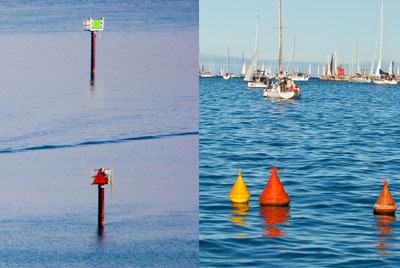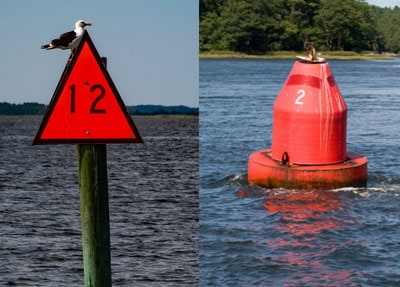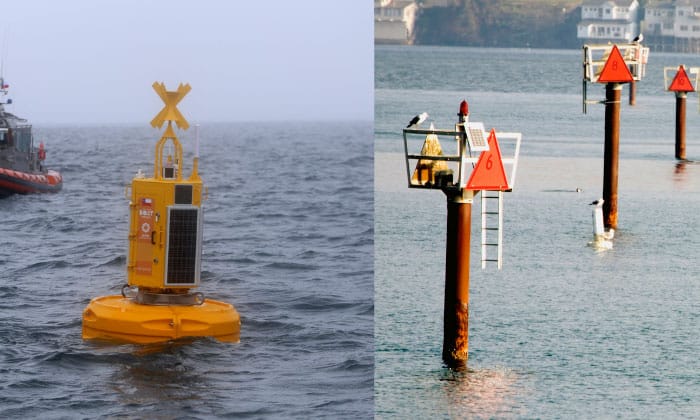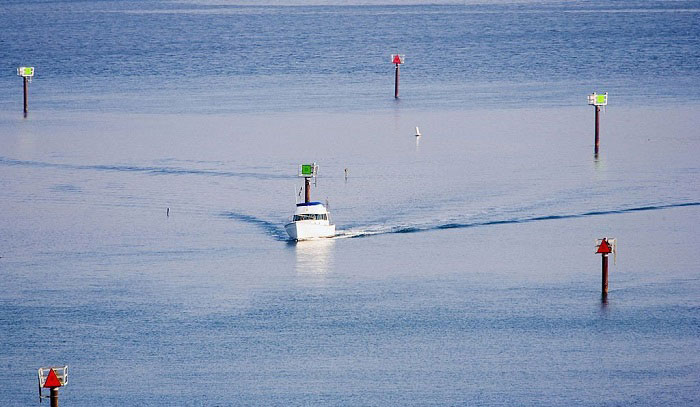If you’re new to boating, the red marks and green buoys can be confusing to look at. So, what are these channel markers and buoys? These arrangements of colors contribute to safe navigation in waterways, just like signs and printed lines for highways. In other words, channel markers & buoys are equivalent to traffic signals.
To learn more about buoys and markers meanings, read on!
Table of Contents
Channel Markers & Buoys: What Are They?
In this section, we’ll discuss lateral markers, specifically boat markers meaning. What do the red and green markers indicate? You can say they’re quite similar to regular signposts of road traffic.
1. Color
You’ll often catch channel markers for boating in two colors: red and green. These colors aid in identifying the side you’d want to pass them on to stay within the edge of a channel.
- If you see a red buoy on your right, it means you’re returning from a bigger body of water to a smaller body of water.
- On the other hand, if you see a green channel marker on your right, you’re pulling off the intercoastal waterway for the open water.
But what side of the channel markers do you stay on? Seafarers often use the term ‘red, right, return’ or ‘red, right, returning’ as a reminder to interpret the channel correctly, as you don’t always encounter red and green channel markers at the same time.
Also, sailors often refer to ‘starboard side’ as your right, and ‘port side’ as your left, so keep that in mind when you’re out boating.
2. Shape
- Nun buoy: These cone-shaped buoys always come in red color with even numbers. With day beacons or boards, the sign is a triangle itself, with no body, whereas channel buoys have a cylindrical body and a cone top.
- Can buoy: These cylindrical-shaped buoys always come in green color with odd numbers. With day beacons or boards, the sign is a square itself, with no body, whereas channel buoys have a cylindrical body and a flat top.
3. Number
The numbers on each channel marker are used to indicate the distance from where you are to open water. Accordingly, the number will increase when you’re close to the harbor, and decrease as you’re close to open water.
As mentioned, odd numbers are seen on green marker buoys and even numbers are seen on red ones.
4. Whole Interpretation
Combining the three factors – color, shape, and number, you’ll be able to interpret the way to safely navigate through a channel out to the sea and back.
To be more specific, as you leave the dock, green marker buoys with odd numbers should be on your starboard side. Conversely, you ought to see red marker buoys with even numbers on your starboard side.
Other Kinds of Markers and Buoys
Now that we’ve had channel markers explained, below are some other types of markers and buoys.
- Day-markers: These are permanent signs that are directly attached to water as posts to maximize its visibility during the day. Some of the commonly seen daymarks are red triangles and green cans, which are relatively similar to nun buoys and can buoys.
- Non-lateral Markers: These markers usually come in white with orange stripes and black lettering. They’re often found on a lake or river for various purposes, including providing information, hazard warning, or marking controlled areas.
- Special Marks: These stand-out yellow marks with a cross (x) on top are used to signify key features or geography of the area, i.e., submarine cables, allocated sports areas, etc. At night, these aids will show a flashing yellow.
- Danger Marks: When you see marks come in red and black horizontal stripes, keep in mind that there are potential hazards on either side. Even though the area is still comparatively safe, you should be careful.
- New Danger Marks (Emergency Wreck Marking Buoys): These marks come in blue with yellow vertical stripes. Similar to regular danger marks, they’re also used to signify hazards in the area. However, these impediments are newly discovered, which have yet to be marked on maps or charts.
- Cardinal Marks: These yellow and black colored marks are used to indicate the cardinal direction of potential underwater hazards. These marks follow the points of a compass, specifically:
- North Cardinal: these marks are colored black over yellow, with the top mark pointing up.
- South Cardinal: these marks are colored yellow over black, with the top mark pointing down.
- West Cardinal: these marks are colored yellow – black – yellow, in order. The top mark includes two black cones apex together, looking similar to a cylinder with a very tight waist.
- East Cardinal: these marks are colored black – yellow – black, in order. The top mark includes two black cones apex apart, looking similar to an egg shape.
- Safe Water Marks (Fairway Buoys): These spherical aids with white and red stripes help indicate that you’re in a safe water area all around.
- Mooring Buoys: These are white marks with blue stripes. They’re used for anchorage and you often need permission to use them.
FAQs
How to Read Channel Markers & Aids to Navigation
Navigation channel markers like the ones we’ve mentioned in the previous section serve as navigational and safety guides; they don’t only aid you in staying within a channel but also give warnings about potential hazards underwater.
It is important to remember and understand these marine channel markers and aids to navigation so you can avoid collisions at all times. To read channel markers in the Intracoastal waterway, you ought to know how to interpret the lateral markers as the Intracoastal waterway markers similar to the red and green buoys.
So, what side of the buoys do you stay on? The yellow triangles should be on your starboard side when riding in a clockwise motion along the Intracoastal, similar to the nun buoys (red triangles). On the other hand, the yellow squares should be on your port side, similar to the can buoys (green cans).
Which Side Do You Pass a Green Buoy?
A green channel buoy is kept to the port side when returning to the port and to the starboard side when proceeding toward the sea.
Conclusion
Understanding the channel markers and buoys helps you navigate through the Intracoastal waterway safely and effectively.
It’s normal to get these markers mixed up if you’re a novel mariner; take your time learning these aids to navigation by heart to avoid sea collision. And remember, always be mindful of the surroundings where you’re at. Have fun boating!

Ten years of enjoying countless trips on boats never made me love them any less! So I am here to put all those experiences into good use for other boaters who want to have a safe and fun trip with their friends and families.





